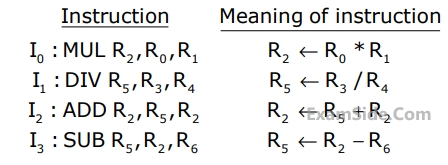1
GATE CSE 2014 Set 1
Numerical
+2
-0
Consider a $$6$$-stage instruction pipeline, where all stages are perfectly balanced. Assume that there is no cycle-time overhead of pipelining. When an application is executing on this $$6$$-stage pipeline, the speedup achieved with respect to non-pipelined execution if $$25$$% of the instructions incur $$2$$ pipeline stall cycles is________________.
Your input ____
2
GATE CSE 2013
MCQ (Single Correct Answer)
+2
-0.6
Consider an instruction pipeline with five stages without any branch prediction: Fetch Instruction $$(FI),$$ Decode Instruction $$(DI),$$ Fetch Operand $$(FO),$$ Execute Instruction $$(EI)$$ and Write Operand $$(WO).$$ The stage delays for $$FI, DI, FO, EI$$ and $$WO$$ are $$5$$ $$ns,$$ $$7$$ $$ns,$$ $$10$$ $$ns,$$ $$8$$ $$ns$$ and $$6$$ $$ns$$, respectively. There are intermediate storage buffers after each stage and the delay of each buffer is $$1$$ $$ns.$$ A program consisting of $$12$$ instructions $${{\rm I}_1},{{\rm I}_2},{{\rm I}_3},......,\,\,{{\rm I}_{12}}$$ is executed in this pipelined processor. Instruction $${{\rm I}_4}$$ is the only branch instruction and its branch target is $${{\rm I}_9}$$. If the branch is taken during the execution of this program, the time (in $$ns$$) needed to complete the program is
3
GATE CSE 2011
MCQ (Single Correct Answer)
+2
-0.6
Consider an instruction pipeline with four stages $$\left( {S1,\,S2,\,S3,} \right.$$ and $$\left. {S4} \right)$$ each with combinational circuit only. The pipeline registers are required between each stage and at the end of the last stage. Delays for the stages and for the pipeline registers are as given in the figure.


What is the approximate speed up of the pipeline in steady state under ideal conditions when compared to the corresponding non-pipeline implementation?
4
GATE CSE 2010
MCQ (Single Correct Answer)
+2
-0.6
A $$5$$-stage pipelined processor has Instruction Fetch $$(IF),$$ Instruction Decode $$(ID),$$ Operand Fetch $$(OF),$$ Perform Operation $$(PO)$$ and Write Operand $$(WO)$$ stages. The $$IF, ID, OF$$ and $$WO$$ stages take $$1$$ clock cycle each for any instruction. The $$PO$$ stage takes $$1$$ clock cycle for $$ADD$$ and $$SUB$$ instructions, $$3$$ clock cycles for $$MUL$$ instruction, and $$6$$ clock cycles for $$DIV$$ instruction respectively. Operand forwarding is used in the pipeline. What is the number of clock cycles needed to execute the following sequence of instructions?


Questions Asked from Pipelining (Marks 2)
Number in Brackets after Paper Indicates No. of Questions
GATE CSE 2025 Set 2 (2)
GATE CSE 2024 Set 2 (1)
GATE CSE 2024 Set 1 (1)
GATE CSE 2022 (1)
GATE CSE 2021 Set 2 (1)
GATE CSE 2021 Set 1 (2)
GATE CSE 2020 (1)
GATE CSE 2018 (1)
GATE CSE 2016 Set 1 (1)
GATE CSE 2016 Set 2 (2)
GATE CSE 2015 Set 3 (1)
GATE CSE 2015 Set 1 (1)
GATE CSE 2015 Set 2 (1)
GATE CSE 2014 Set 3 (2)
GATE CSE 2014 Set 1 (1)
GATE CSE 2013 (1)
GATE CSE 2011 (1)
GATE CSE 2010 (1)
GATE CSE 2009 (1)
GATE CSE 2008 (4)
GATE CSE 2007 (1)
GATE CSE 2006 (1)
GATE CSE 2005 (1)
GATE CSE 2004 (1)
GATE CSE 2002 (1)
GATE CSE Subjects
Theory of Computation
Operating Systems
Algorithms
Database Management System
Data Structures
Computer Networks
Software Engineering
Compiler Design
Web Technologies
General Aptitude
Discrete Mathematics
Programming Languages